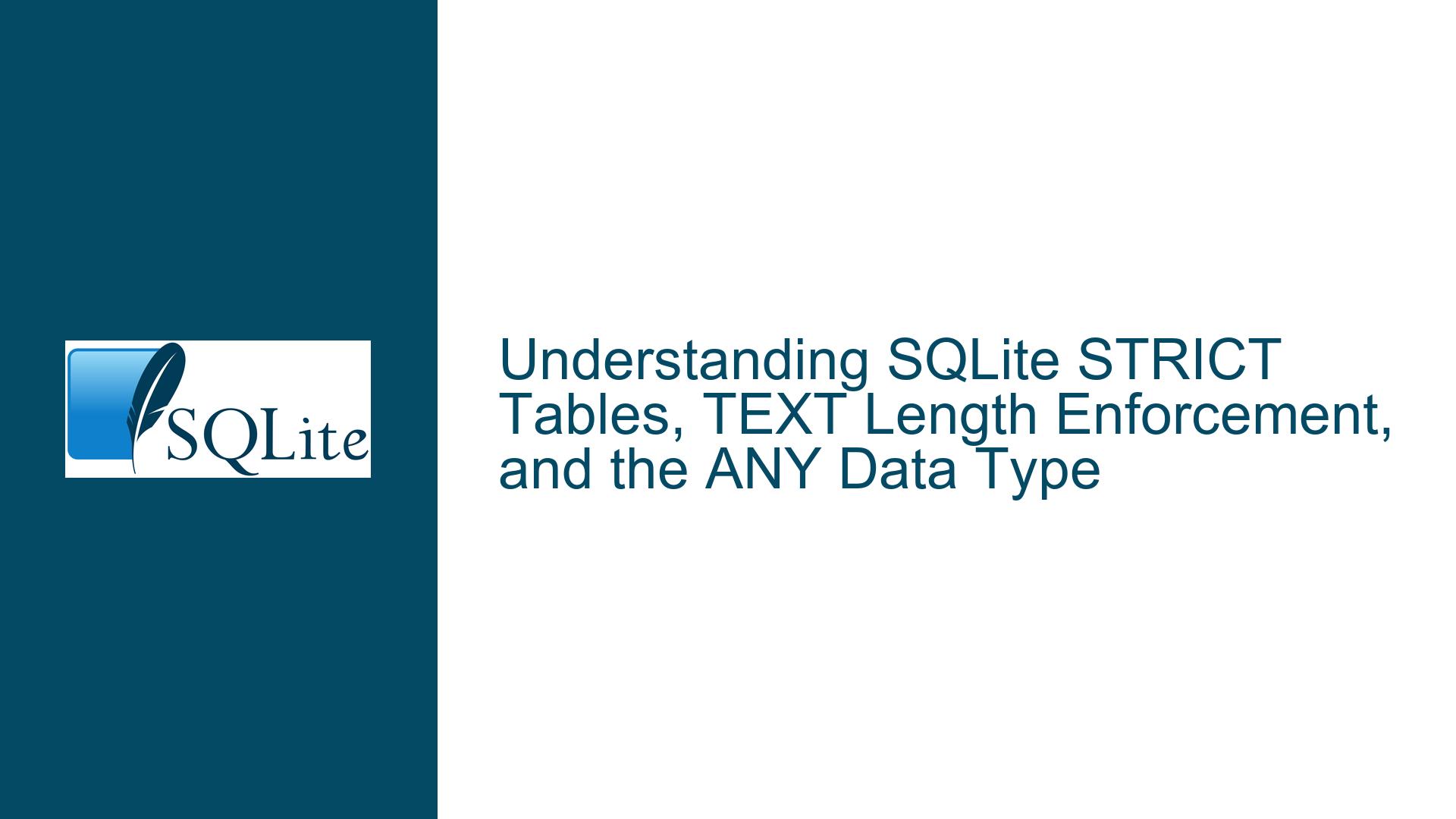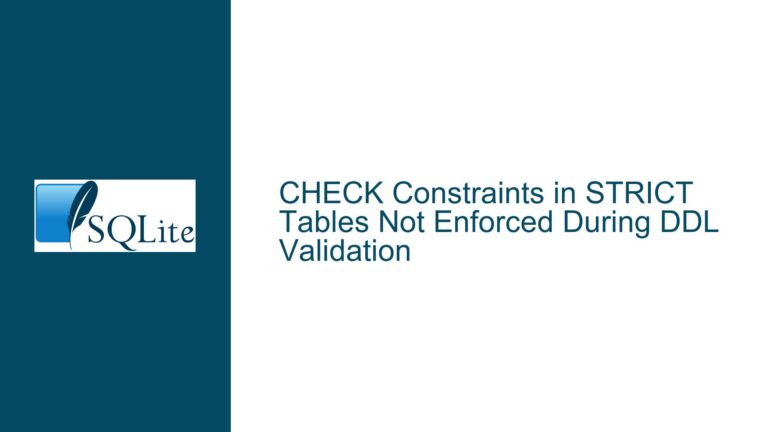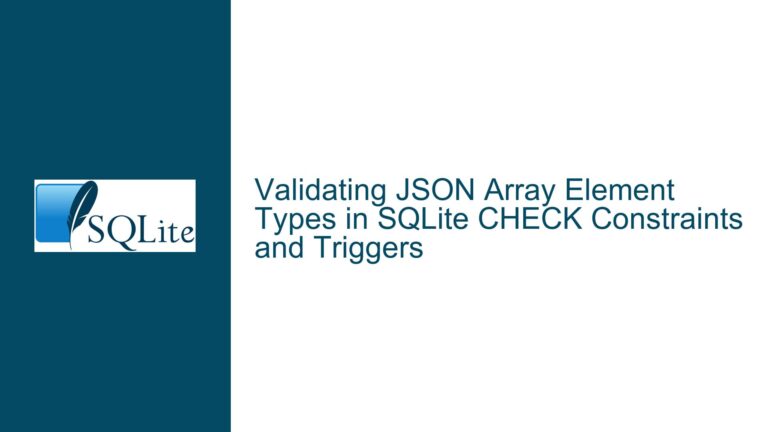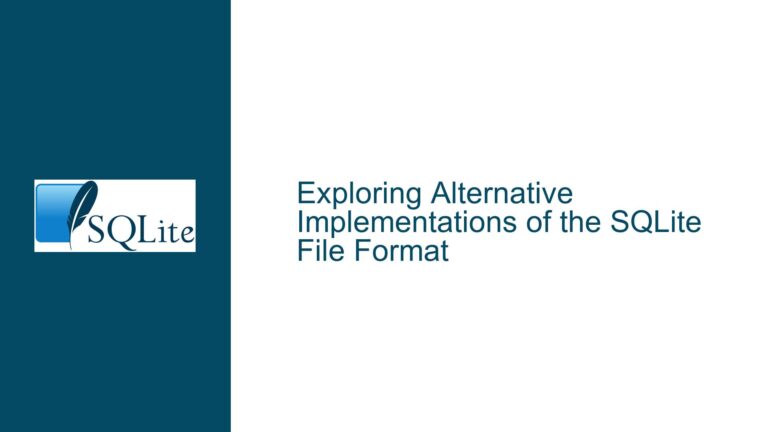SQLite STRICT Tables, TEXT Length Enforcement, and the ANY Data Type
Issue Overview: STRICT Tables, TEXT Length Enforcement, and the ANY Data Type
SQLite’s introduction of STRICT tables in version 3.37.0 marked a significant shift in how developers can enforce data integrity at the schema level. STRICT tables allow developers to define columns with specific data types, ensuring that only values of the specified type can be inserted into those columns. This feature is particularly useful for applications that require strong data typing and consistency, as it prevents the insertion of incompatible data types that could lead to runtime errors or data corruption.
However, the implementation of STRICT tables has raised several questions and concerns among developers, particularly regarding the enforcement of TEXT column lengths and the inclusion of the ANY data type. The discussion revolves around whether SQLite should enforce length constraints on TEXT columns, the utility of the ANY data type in STRICT tables, and the potential for introducing a USER-defined data type that allows developers to specify custom data patterns.
The core issue can be broken down into three main areas:
TEXT Length Enforcement in STRICT Tables: Developers are questioning whether SQLite should enforce length constraints on TEXT columns within STRICT tables. The concern stems from the desire to prevent data corruption, reduce database size, and ensure data consistency, especially when dealing with inherited application code or data imports.
The Role of the ANY Data Type in STRICT Tables: The inclusion of the ANY data type in STRICT tables has been met with skepticism. Some developers argue that it undermines the purpose of STRICT tables by reintroducing the flexibility of dynamic typing, which STRICT tables are designed to eliminate. This raises questions about the practical use cases for the ANY data type and whether it should be allowed in STRICT tables at all.
Potential for USER-Defined Data Types: Developers have expressed interest in the ability to define custom data types within SQLite, similar to how CHECK constraints can be used to enforce specific data patterns. This would allow for more granular control over data validation, such as enforcing email formats, GUIDs, or numeric codes with specific separators.
Possible Causes: Why These Issues Arise
The issues surrounding TEXT length enforcement, the ANY data type, and USER-defined data types arise from a combination of historical context, practical use cases, and the evolving needs of modern applications.
Historical Context and Legacy Systems: The desire for TEXT length enforcement can be traced back to the legacy systems where fixed-length fields were common. In such systems, enforcing length constraints was necessary to maintain data integrity and optimize storage. While modern databases like SQLite have moved away from fixed-length fields, the need for length enforcement persists, especially when dealing with legacy code or data imports that may contain unexpected or malformed data.
Data Integrity and Consistency: The primary motivation behind STRICT tables is to enforce data integrity and consistency. Developers expect STRICT tables to provide a robust mechanism for ensuring that only valid data is stored in the database. The inclusion of the ANY data type, which allows for dynamic typing, seems to contradict this goal. This has led to confusion and concern among developers who rely on STRICT tables to enforce strong data typing.
Flexibility vs. Strictness: The ANY data type introduces a level of flexibility that some developers find useful, particularly in scenarios where the data type of a column may vary. However, this flexibility comes at the cost of strictness, which is the primary benefit of STRICT tables. The tension between flexibility and strictness is a key factor in the debate over the ANY data type.
Custom Data Validation Needs: The interest in USER-defined data types reflects the growing need for more sophisticated data validation mechanisms. While CHECK constraints can be used to enforce specific data patterns, they are limited in their expressiveness and can become cumbersome for complex validation rules. A USER-defined data type would provide a more elegant and reusable solution for enforcing custom data patterns.
Troubleshooting Steps, Solutions & Fixes: Addressing the Core Issues
To address the issues surrounding TEXT length enforcement, the ANY data type, and USER-defined data types, developers can take several approaches, ranging from leveraging existing SQLite features to proposing enhancements to the SQLite engine.
Enforcing TEXT Length Constraints: While SQLite does not natively enforce length constraints on TEXT columns, developers can achieve this functionality using CHECK constraints. For example, to enforce a maximum length of 40 characters on a TEXT column, the following schema definition can be used:
CREATE TABLE foo ( foo INTEGER PRIMARY KEY, bar TEXT CHECK(length(bar) <= 40) );This approach ensures that any attempt to insert a value longer than 40 characters into the
barcolumn will result in an error. Additionally, developers can use thetrimfunction to remove leading and trailing spaces, further ensuring data consistency:CREATE TABLE foo ( foo INTEGER PRIMARY KEY, bar TEXT CHECK(length(trim(bar)) <= 40) );While this solution requires manual implementation, it provides a robust mechanism for enforcing TEXT length constraints without requiring changes to the SQLite engine.
Understanding the ANY Data Type: The ANY data type in STRICT tables serves a specific purpose: it allows developers to retain the flexibility of dynamic typing for individual columns while still enforcing strict typing for the rest of the table. This can be useful in scenarios where the data type of a column may vary, such as when dealing with polymorphic data or legacy systems that do not enforce strict typing.
Developers who do not require this flexibility can simply avoid using the ANY data type in their STRICT tables. By doing so, they can maintain the benefits of strict typing without introducing unnecessary complexity. For those who do need the flexibility, the ANY data type provides a valuable tool for managing dynamic data.
Exploring USER-Defined Data Types: While SQLite does not currently support USER-defined data types, developers can achieve similar functionality using CHECK constraints and the
REGEXPfunction. For example, to enforce a specific pattern for email addresses, the following schema definition can be used:CREATE TABLE users ( user_id INTEGER PRIMARY KEY, email TEXT CHECK(email REGEXP '^[^@]+@[^@]+\.[^@]+$') );This approach allows developers to enforce custom data patterns without requiring changes to the SQLite engine. However, it is worth noting that the
REGEXPfunction is not part of the standard SQLite build and must be enabled through extensions or custom builds.For more complex validation rules, developers can create custom functions using SQLite’s C API and register them as user-defined functions. This approach provides a high degree of flexibility and allows for the implementation of sophisticated data validation logic.
Proposing Enhancements to SQLite: For developers who require native support for TEXT length enforcement or USER-defined data types, proposing enhancements to the SQLite engine is a viable option. The SQLite development team is known for being responsive to community feedback, and well-reasoned proposals for new features are often considered.
When proposing enhancements, it is important to provide a clear rationale for the feature, along with examples of how it would be used in practice. For example, a proposal for native TEXT length enforcement could include examples of how it would improve data integrity and reduce the need for manual validation. Similarly, a proposal for USER-defined data types could include examples of how it would simplify the implementation of complex data validation rules.
By engaging with the SQLite community and contributing to the development process, developers can help shape the future of SQLite and ensure that it continues to meet the needs of modern applications.
Conclusion
The issues surrounding TEXT length enforcement, the ANY data type, and USER-defined data types in SQLite highlight the ongoing tension between flexibility and strictness in database design. While SQLite provides a robust set of tools for enforcing data integrity, there are still areas where developers may encounter challenges or limitations.
By leveraging existing features such as CHECK constraints and user-defined functions, developers can address many of these challenges without requiring changes to the SQLite engine. For those who require additional functionality, proposing enhancements to SQLite is a viable option that can help shape the future of the database.
Ultimately, the key to successfully navigating these issues lies in understanding the trade-offs involved and choosing the approach that best meets the needs of your application. Whether you prioritize strict data typing, flexibility, or custom validation rules, SQLite provides a powerful and flexible platform for building robust and reliable applications.






